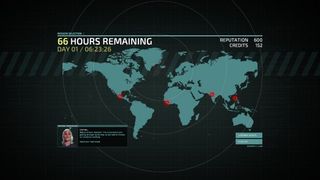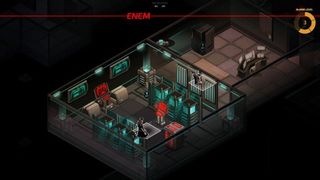Invisible, Inc. review (Early Access)

Alpha and Early Access reviews offer our preliminary verdicts on in-development games. We may follow up this unscored review with a final, scored review in the future. Read our full review policy for details.
Version reviewed: Early Access 19.08.14
Reviewed on: AMD FX 4200, GTX 660 Ti, 16gb RAM
Recommended: You can almost definitely run it.
Price: $16/£12
Publisher/Developer: Klei Entertainment
Multiplayer: Nope
Link: Steam store page
Invisible, Inc. proves that the logic of stealth games fits turn-based strategy conventions very well, even if it's a little too difficult to fully enjoy right now. Its most obvious influence is X-COM, as it put me in charge of a group of spies with 72 hours to prepare for a final mission. In the time I have until then, I choose between procedurally-generated missions from a global map, weighing the time they'll take to complete and level of security against the potential rewards, and deploy my agents.
Once on the ground, the security forces and I take turns spending action points to move across tiles in the facility. My goal is to collect as many assets as I can that will serve me in future missions and find the elevator to the roof to reach my extraction point. How long I want to stay and how many risks I want to take before bugging out is completely up to me.
Klei's Mark of the Ninja worked because it quantified and visualized all the information you needed to become a stealthy ninja: lines of sight, sound, and the benefits of every gadget. Invisible, Inc. takes that transparency even further by giving you the same information and giving you the time to plan out literally every step you take. Whereas other games in the genre heavily rely on good timing and accuracy, I liked that Invisible, Inc. made stealth strictly a game of wits.

I don't need to think fast, but carefully. I quickly learn to always end an agent's turn in a hiding spot, stay out of guards' lines-of-sight, and peek around corners before going into the unknown. When all else fails, I use one of my agents' precious few special abilities—a gun, or a cloaking device that lasts for one turn.
There's rarely a great solution, only a workable one. Guns are hard to come by and carry only a couple of bullets. Melee taser attacks knock guards out quietly, but only for a couple of turns, and the taser needs to cool down. It made what little victories I achieved all the more meaningful, but I still wish I got to use my tools more often. It would make things a little bit more manageable, but also make every turn more interesting.
The Incognita tool exposes the facility's automated security, allowing me to expend limited energy to turn off laser traps, hijack cameras and turrets, and break into computers and safes to collect assets. It's one of the few ways in which I have the upper hand, but even using Incognita is risky. One of the best ways to get rid of a guard for good is to lead him within range of a hijacked turret, but many devices are protected by firewalls that deploy countermeasures to increase security or send in special, armored guards. It's another smart way Invisible, Inc. makes you consider every decision you make. Everything comes at a price, one way or another.
PC Gamer Newsletter
Sign up to get the best content of the week, and great gaming deals, as picked by the editors.

Get smart
As a completionist, my inclination was to explore every room and collect everything there is to collect before moving on. After losing all my agents on the first mission a handful of times, I realized that this simply wasn't going to work.
The level of security continues to rise no matter how well I'm hidden, slowly turning on more security cameras and sending in more guards. If a guard sees me and I can't get into cover within one tile, my agent is dead forever. Cracking another safe for a few hundred dollars I can use to upgrade my agents with more action points or gadgets is tempting, but dead agents have exactly zero action points.

Sprinting to the end of every level worked for a time, but a few missions later I found myself with two agents in the field facing much tougher guards and security measures. They, by comparison, were barely upgraded at all, and fresh out of ammo.
Complete and utter failure is part of the process and that's almost OK, because I never walked away with nothing. Each attempt ends with a high score based on how many guards I took out, how many objectives I completed, and usually a good story: a bulletproof plan that fell to pieces because my agent triggered a security daemon while hacking a mainframe.
Each run adds to a persistent experience meter, which eventually earns new agents and gadgets for future attempts. It's a great way to soften Invisible's many merciless blows. Getting something out of every attempt gives a good reason to keep trying, and I hope Invisible, Inc. adds more of these motivations or offers easier modes before release.

At the moment, Invisible, Inc. is hard to the point where I feel like I'll never reach the final mission let alone beat it, and it's a shame because I really want to see all of it. This is in large part because it hits the espionage tone so perfectly. It doesn't have a story, but doesn't really need one since it establishes characters and mood perfectly with suspenseful music and beautifully conceived characters. Your commander, known only as Central, is a gaunt, stern, silver-haired Brit, whose no nonsense mission briefings set the tone for the cruel realities.
Deckard, your first agent, is the archetypical sleuth with a big scary trench coat and fedora that are undermined by a cute, Norman Rockwell-esque pink nose. Most of what you see of your agents are in a little looping animation in the corner of the screen while you have them selected, but with the addition of the music and the slick, cyber punk UI, Invisible, Inc. sells the world just as well as Splinter Cell or other, bigger, spy-fictions.
Verdict
Invisible, Inc. borrows from X-COM wisely while adding enough of its own flavor to make it more than just a copycat. It's not as big or as accessible of a game, but the stealth and turn-based strategy mashup is new, and highlights what's most fun about both genres.
Outlook
Good. Klei has made another great stealth game and it's so committed to keep improving on what it already has, it made the brave move of displaying a countdown to the next build on the game's main menu. It'd be great if it got a bigger scale, with more to do between missions and a more accessible difficulty, but it's already good.
